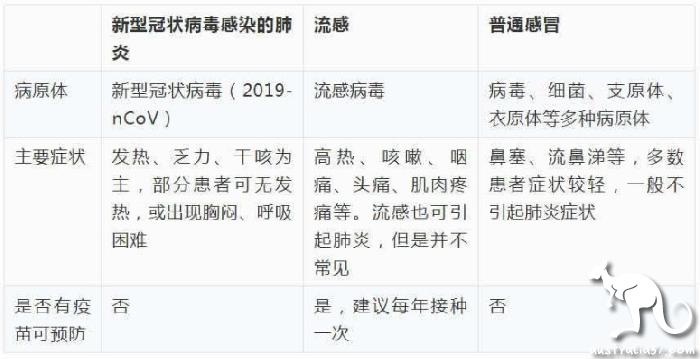How does the symptoms of new coronary virus pneumonia differ from those of influenza
The main symptoms of influenza are fever, headache, myalgia and general discomfort, body temperature can reach 39~40℃, can have chills, shivering, many with systemic muscle joint pain, fatigue, loss of appetite and other systemic symptoms, often sore throat, dry cough, can have nasal congestion, runny, sternum discomfort and so on. Face flushed, conjunctiva hyperemia. Some of them are characterized by vomiting, abdominal pain and diarrhea, which are common in children infected with influenza B. The course of disease without complications was self-limited, more than 3~4 days after the onset of body temperature returned to normal, systemic symptoms improved, but cough, physical recovery often took 1~2 weeks.
Pneumonia is the most common complication of influenza. Other complications include nervous system injury, heart damage, myositis, rhabdomyolysis syndrome and septic shock.
According to the existing case data, the main manifestations of new coronary virus pneumonia are fever, dry cough, fatigue and so on. A few patients are accompanied by nasal congestion, runny nose, diarrhea and other upper respiratory and digestive tract symptoms. Most of the severe cases developed dyspnea after 1 week. In severe cases, acute respiratory distress syndrome, septic shock, refractory metabolic acidosis, coagulation dysfunction and multiple organ failure occurred rapidly. It is worth noting that the course of severe and critical patients can be medium and low fever, or even no obvious fever. Mild patients only showed low fever, slight fatigue and no pneumonia. From the current cases, most patients have a good prognosis and a few are critically ill. The prognosis of the elderly and those with chronic basic diseases is poor. The symptoms of children are relatively mild.

How does the symptoms of new coronary virus pneumonia differ from those of influenza
Respiratory symptoms, how to determine whether they are infected with new coronary pneumonia?
Based on the current flow pathology survey, the incubation period is 1-14 days, mostly 3-7 days. Fever, fatigue and dry cough were the main symptoms, and a few patients were accompanied by occlusion, runny nose, sore throat, myalgia and diarrhea. Severe patients developed dyspnea or hypoxemia at 1 week after onset. Severe patients developed rapidly into acute respiratory failure (acute respiratory distress syndrome), sepsis and multiple organ failure. It is worth noting that some patients have mild symptoms, no fever, no pneumonia. Most patients are mild. Good prognosis, a small number of patients are critically ill and even death.
If there are early clinical manifestations, such as fever, fatigue, dry cough, does not mean that has been infected. Patients with fever (axillary body temperature ≥37.3 C), cough, shortness of breath and other symptoms of acute respiratory tract infection, with a history of Wuhan travel or residence, or who have come into contact with fever with respiratory symptoms within 14 days before onset, or have a small area of aggregation, should be investigated and treated at a local designated medical institution.
Fever, how to see a doctor?
During the epidemic period, if there is fever, we should report to the village (residential) committee or medical and health institutions in time, cooperate with the relevant investigation, diagnosis and treatment. During the visit, should wear a medical surgical mask or N95 mask, to the fever clinic. When seeking medical treatment, we should tell the situation of illness and past medical treatment truthfully, especially inform the doctor of recent travel and residence history, contact history with patients with new coronary pneumonia or asymptomatic infection, animal contact history, etc.
If diagnosed as a suspected case of new coronary virus pneumonia, will be admitted to hospital isolation treatment. Meanwhile, throat swab and sputum samples were collected for new coronary virus detection, and blood samples were used for serum new coronary virus specific antibody detection. If any test result is positive, it is diagnosed as new crown pneumonia.
Which is the new crown pneumonia susceptible crowd?
1. elderly population
Pay attention to the current "age distribution of infected Coronavirus ", the proportion of" elderly people "is the largest, and the prevalence and death rate of elderly patients belong to" the largest share of age distribution ". Comparatively speaking, the old people's body ability is in the decline stage, the organ ability and the immune ability are lower than the young people, so they are more likely to be "defeated by the Coronavirus ", and the risk of illness will naturally be higher.
Crowds 2. crowded places
The "new coronal virus" is more likely to be infected by droplets, so where there are many people, the risk of infection is naturally higher. There are many people in real life who are "not willing to be lonely" and are always used to staying and playing in crowded places. Some people may also be due to special reasons at work. However, in closed, airless and crowded places, the virus infection is more likely to occur.
3. population with "certain underlying diseases" in its own right
According to official media data, it is found that a large proportion of the "severe new coronary virus pneumonia" patients belong to the patients with respiratory diseases, hypertension, diabetes, cirrhosis and other problems, and the population with serious basic diseases also belongs to the "new crown susceptible population ", which needs to be focused on.
4. people with poor living habits and low immunity
Common life does not like exercise, sitting for a long time, smoking, drinking; it is easy to be next to the next person cold, indicating that "relatively low resistance ", this kind of people are also Coronavirus susceptible people. These people need to adjust their lifestyle and diet, exercise more, eat and sleep balance, and enhance their defense against virus. Besides, children, pregnant women and medical staff in contact with patients are also "Coronavirus susceptible people ", who need to" focus on prevention and control "in their lives to avoid being attacked by the epidemic.

